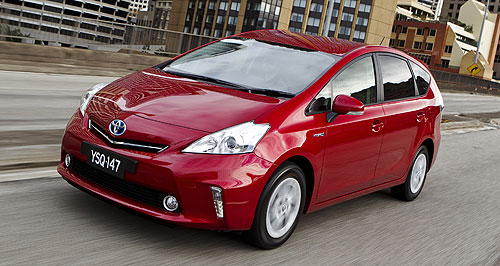News - Toyota - Prius VToyota crash claims to go untested in AustraliaCrash course: Australia’s road safety watchdog is unable to test US claims that the Toyota Prius V’s collision-avoidance technology does not work. Road safety watchdog admits it is lagging anti-crash technology leaps11 Oct 2013 By BARRY PARK AUSTRALIA will need to wait until at least next year to assess if US claims that Toyota’s anti-collision technology does little to help in a crash are valid. The news comes as the law firm that savaged Toyota to the tune of $US1.6 billion over unintended acceleration problems in the Prius announced this week that it would have another go at the car-maker – although this time its target is the Prius V people-mover. McCuneWright announced this week that it would launch another class action against the Japanese car-making giant over a US Insurance Institute for Highway Safety crash test analysis that showed the car’s anti-collision technology did little to help drivers avoid a crash into the back of a vehicle in front. The lawsuit, filed in California, alleges that since at least 2010, Toyota has marketed and sold a safety option called the Pre-Collision System (PCS) in its high-end Prius V vehicles. According to McCuneWright, the lawsuit claims that Toyota represents in its marketing materials and owner's manual that the PCS uses radar to sense an unavoidable frontal collision, and then if needed, automatically applies the Prius V’s brakes to prepare for an accident. “The PCS is part of an advanced technology package option that usually sells for over $US5000,” a press release announcing the class action said. “The PCS option is believed to make up approximately $US1000 of that cost.” The class action is based on an IIHS investigation of the Prius V’s collision-avoiding technology that suggested it did little to help drivers. “In vehicle testing by the Insurance Institute of Highway Safety, the Toyota Prius (V) was one of only two models that failed to get any rating, leading the IIHS to state: ‘The Toyota Prius V wagon, which claims to have autobrake, had minimal braking in IIHS tests and currently fails to meet NHTSA criteria for forward collision warning. It doesn't qualify for an IIHS front-crash prevention rating’,” McCuneWright said. “The lawsuit seeks to force Toyota to reimburse owners for the cost of the PCS and to force Toyota to discontinue marketing that the PCS provides automatic braking.” The core of the law firm’s claim against the Prius centred around an argument that Toyota should have provided the car with a brake override system, that would allow the driver to pull the petrol-electric hatchback up no matter what was happening under the bonnet. Toyota Australia media and external affairs manager Beck Angel told GoAuto there had been no fallout in Australia from the US-based Prius lawsuit, but did not comment on the latest class action. However, the IIHS’s claims that the Prius V’s anti-collision technology does little to help avoid a crash will go untested in Australia until at least next year as the Australian road crash safety watchdog struggles to catch up with car-maker’s advances. Australasian New Car Assessment Program chief executive Nicholas Clarke said ANACP was already in talks with car-makers over how to test the new technology, which he said had real potential to reduce road trauma and insurance costs. “We are looking to include some of these anti-collision technologies (as part of ANCAP testing), particularly autonomous emergency braking, over the next few years, and we're very interested in the tests being undertaken by the IIHS,” Mr Clarke said. However, he said ANCAP would have to wait until its crash safety partner, EuroNCAP, had developed a test regime for anti-collision technology before it could start assessing how well they worked. “It's not unusual, I think, for some of the early technologies to perhaps be less effective than some people might think,” Mr Clarke said. “I think you can say the same anecdotally about the ABS (anti-lock braking system) experience in the 1980s and '90s, and even the early days of electronic stability control in the late 1990s to early 2000s. “But we are conscious of the need of systems to perform, and that's why we will be following this and looking to test these systems when they come into the NCAP protocol. “We're still in discussions with industry about that.” Mr Clarke said ANCAP hoped to have its own test for how well anti-collision technology worked “within a couple of years”.  Read more |
Click to shareToyota articlesResearch Toyota Prius V pricing
Motor industry news |

















Facebook Twitter Instagram